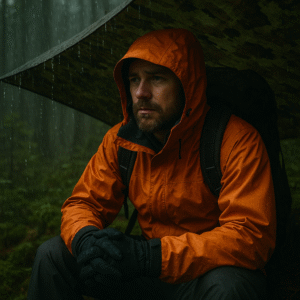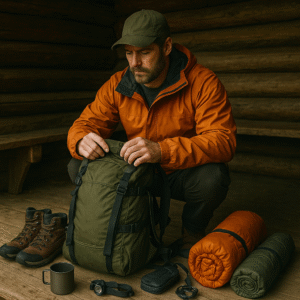Heading out on a solo hike isn’t just about getting away from it all. It’s a real way to recharge, test your limits, and experience wild places at your own pace. I love how solo hiking lets me set my own rhythm, stop whenever I want, and just take in the scenery. Still, getting the right gear lined up is super important for safety and peace of mind. Whether you’re prepping for a day hike or a multiday adventure, I’ve put together my favorite essential solo hiking gear that makes heading out alone a lot more comfortable and way safer.

Why Gear Matters on Solo Hikes
On a solo hike, you’re your own backup. There’s no one to borrow a map from, no friend to lend an extra snack, and definitely no easy ride out if something goes wrong. That’s why solid gear isn’t just a convenience; having the right stuff can make or break your experience. Even if you stick to marked trails, conditions can change fast. Trail closures, surprise storms, or a misstep far from help can turn a basic hike into a real challenge. Carrying practical, well-thought-out gear helps you avoid unnecessary risks and makes hiking alone a lot more stress-free and rewarding.
The hiking gear market has grown a ton recently, and more people now take solo trips into the outdoors. The increase in high-quality, lightweight options means you don’t need to pack like you’re going on an Antarctic expedition every time. But it can be tough to cut through all the options, so I’ll break down what actually helps when you’re solo on the trail.
Really Important Gear For Solo Hikers
Here are the things I never leave behind when hiking alone. I’m going over each item, what it does, and some thoughts on picking the best option for your needs.
- Packed Water and Purification: I always start hikes with more water than I think I’ll need, but I also carry a water filter or purifier. Lightweight squeeze filters are pretty handy, and tablets work in a pinch. If you can’t find a stream or spring, you’ll still want to have enough for emergencies.
- Maps, Compass, and GPS: Oldschool navigation seems unnecessary if you’re used to hiking popular trails, but paper maps and a compass never lose signal. I also use GPS apps on my phone, but I bring a power bank to keep it running. A small, reliable GPS device can add extra security.
- Easily Accessible First Aid Kit: My first aid kit is always within reach, usually in an outer pocket or belt pouch. I make sure it’s stocked with basics for blisters, small wounds, and pain relief. For longer trips, I add items like a tick remover and waterresistant bandages.
- Lightweight Emergency Shelter: Even on day hikes, an ultralight bivy or emergency blanket gives me peace of mind. Getting caught overnight (even accidentally) is way less scary with minimal cover to block wind or rain.
- Fire-Making Tools: I pack a couple of waterproof matches, a lighter, and sometimes a tiny fire starter. Starting a fire could be a lifesaver if you need warmth, so having a few backup options is just smart planning.
- Headlamp or Flashlight: The weather or my own exploring sometimes means finishing up after dark, so a good headlamp with spare batteries is nonnegotiable for me. Your phone’s flashlight isn’t enough when you’re deep in the woods.
- Charged Power Bank: For all the helpful digital gear I carry, I back it up with a lightweight power bank. Cold weather drains phone batteries fast, so a power bank keeps my GPS and emergency contacts working.
- Multitool or Knife: Fixing gear, prepping snacks, or minor first aid—my knife is always useful. I keep it sharp and simple, with basics like scissors and tweezers to handle more than just food prep.
- Extra Layers and Rain Gear: Weather turns quickly in wild areas, so a packable rain jacket and one extra warm layer live in the bottom of my pack. Even if the forecast looks clear, I still bring these just in case.
- Personal Locator Beacon (PLB) or Satellite Messenger: On remote solo hikes, I bring a PLB or a satellite messenger like Garmin inReach. Hitting “SOS” is an option I hope I never need. Even for short treks, being able to message for help when you’re out of cell service is reassuring for both me and my family.
How to Choose Solo Hiking Gear That Works
Choosing gear for solo hiking can feel overwhelming, so here’s how I narrow it down.
- Focus on Weight and Packability: When you’re on your own, you carry every single thing. Picking lighter and more compact items makes hiking longer or trickier trails a lot more enjoyable.
- Reliability Over Cool Features: Rugged, dependable gear is the real MVP on tough hikes. I’d rather have an old workhorse of a rain jacket than the fanciest new tech that’s “cutting edge” but not proven in the wild.
- Ease of Use: Solo hiking leaves no one to help fiddle with complex tents or gear. If I can’t set it up, pack it down, or fix it myself, it doesn’t make the cut.
- Modularity: Items that do double duty (like a bandana as sun cover or first aid) free up space and weight for more food or water.
Solo Hiking Challenges and How to Handle Them

Even my best-laid plans hit a few bumps sometimes. Here’s a look at the common solo hiking hurdles and how I deal with them:
- Navigation Fumbles: I’ve missed trail markers or misread the map, especially in lesstraveled spots. That’s why I doublecheck the route beforehand, keep my map handy, and use GPS for crosschecking. Keeping a cool head and backtracking calmly usually gets me back on track.
- Weather Surprises: Fastmoving weather is just part of hiking solo. I always check the forecast, but packing an extra layer or a twoounce emergency shelter doesn’t slow me down, and it keeps me safer if things go sideways.
- Running Low on Food or Water: Long days or tough sections can eat through supplies. I keep an extra pack of highenergy snacks and make sure I know where every potential water source is along my route. When in doubt, I overpack just a little.
- Small Injuries: Blisters, scrapes, or twisted ankles are way more stressful when you’re alone. Having a wellstocked first aid kit and walking poles for support helps. I never ignore a problem; taking a minute to tend to a hot spot can save a lot of pain down the road.
- No Cell Service: It happens way more often than most new hikers expect. Along with telling someone exactly where I’ll be, I rely on my satellite messenger in remote places and always make sure any navigation app is available offline.
Navigation Tools
It’s easy to get turned around when you’re solo, even on marked trails. I keep paper maps in a dry bag, download digital routes, and make sure my compass skills are sharp. Sometimes I bring a small patch kit in case my map gets torn up by the weather. If I’m planning a hike in an unfamiliar area, I dig into trip reports or recent trail updates to spot any issues before heading out.
First Aid Kit Essentials
My first aid kit for solo hikes is a little beefier than a group kit. I always have way more blister bandages than I think I’ll need, some real painkillers (not just ibuprofen), and burn or rash ointment. Being able to take care of small things on my own lets me hike longer and more comfortably. I even throw in a small splint and some extra gauze just in case something bigger comes up when far from help.
Emergency Communication
Honestly, carrying a simple emergency beacon or a small satellite device gives me and my family a lot of peace of mind. Most of these also let me send quick “I’m okay” check-in messages at preset intervals, which is a nice touch that’s saved me a ton of stress when hiking off the grid. Some models also allow basic texting, so I can share my location updates if needed, especially when trails are unexpectedly tricky or take longer than planned.
Helpful Solo Hiking Tips

Gear gets you part of the way, but it’s also about how you use it. Here’s what I’ve learned from solo hiking the hard way (and a few things I picked up from seasoned veterans):
- Test gear and shoes on shorter hikes before heading out for a long adventure. Breaking in boots on local trails saves a lot of pain down the road.
- Always let someone know your route (even if you think cell service will be available). Share your trip plan and check in when you finish.
- Pace yourself and build up to longer or tougher solo trips. Starting on easy trails leads to more confidence and comfort on challenging routes.
- Aim to arrive at your planned finish point before dark, and add a time cushion for unexpected delays. This makes the end of your hike less stressful.
- Trust your instincts; if something feels off, turn back. Solo hiking is freedom, so switching up plans is always an option.
One more thing: practice basic outdoor skills like fire starting, quick first aid, and reading a topographic map. Being prepared to handle surprises makes solo hiking even more rewarding.
FAQs: Solo Hiking Gear Basics
Here are questions I hear a lot from folks brand new to heading out solo:
What size backpack works best for solo hiking?
For most day hikes, a 20-30L pack handles food, water, layers, and first aid. For overnights, something up to 50L gives space for shelter and extra gear without being too bulky.
Do I really need a satellite beacon?
If you’re sticking to popular trails or have phone service most of the route, you might not. But for peace of mind on remote, solo trips, I wouldn’t go without one anymore.
How much emergency food is enough?
I carry enough for an extra meal or two, plus a couple of snacks. Bars, trail mix, and jerky keep well and don’t take up much space. Plus, they’re quick to eat if you need a fast energy boost.
Final Thoughts: Building Your Confidence for Solo Hiking

Having the right essential gear gives you a better solo hiking experience, helps you stay safe, and lets you focus on the sights and sounds around you. Over time, your setup will grow to fit your style of hiking. Testing gear, practicing, and staying informed means you’ll always be ready for whatever the trail throws your way.
Setting out solo is about freedom, challenge, and a connection to nature. With the right tools and mindset, every solo hike can be an adventure worth repeating. And as you get more experience, you’ll not only be safer but also get even more enjoyment out of every adventure alone on the trail.
